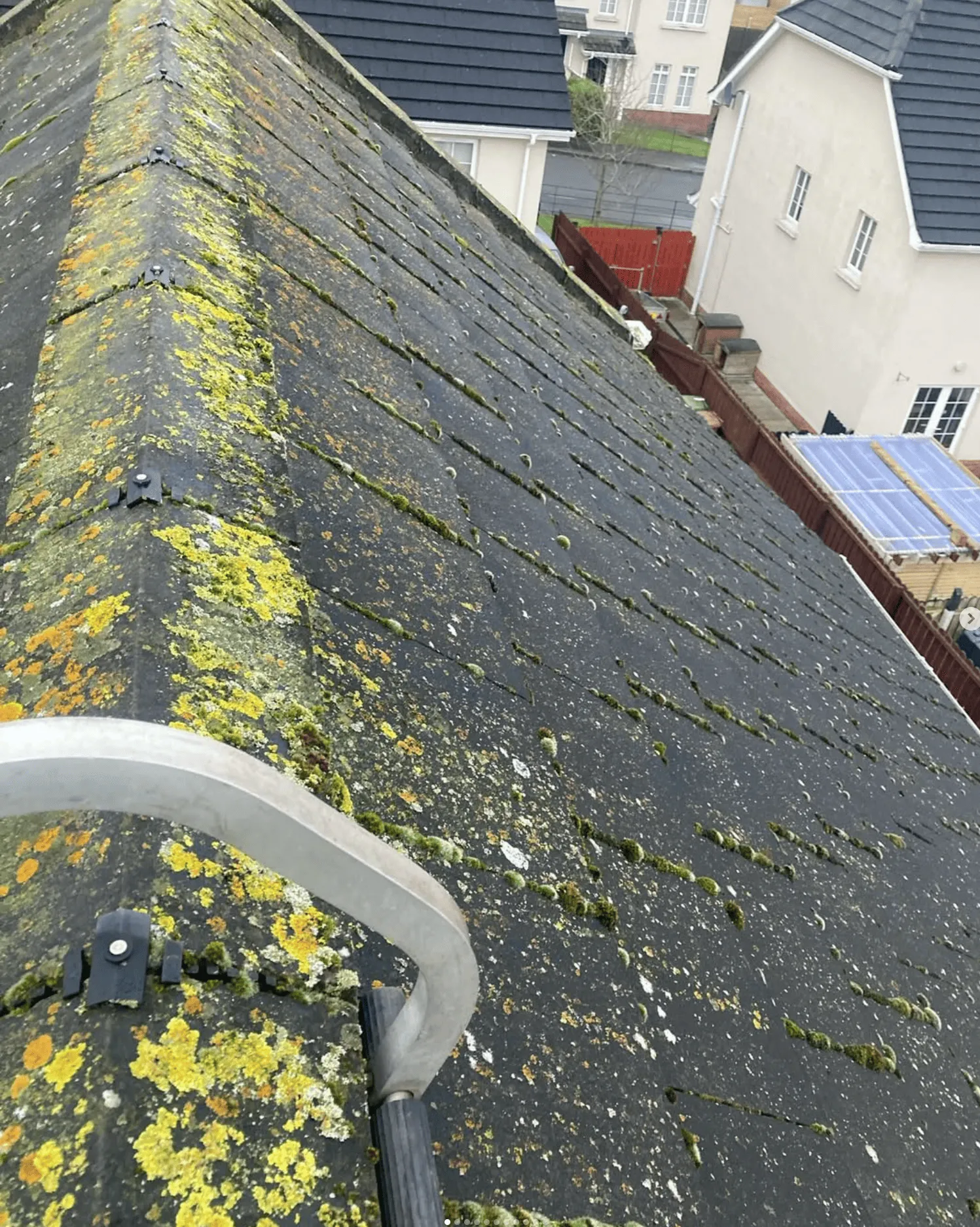Roof algae and moss growth is a common problem for many of us, especially in humid areas or areas with limited sunlight due to overhanging trees or nearby buildings. At first glance, it looks like a minor issue, but the truth is moss growth and algae can cause significant damage to your roof over time. They not only detract from the look of your home, with black streaks and ugly marks but also compromise your roofing materials. Knowing what causes moss and algae growth, how to prevent them, and the best removal method is vital to keeping your roof in top shape and avoiding costly repairs.
In this guide we will cover the causes of roof algae and moss growth, the impact on different types of roofing materials and the best practices for prevention and removal. We will also cover safety precautions to take during the cleaning process and when to seek professional cleaning services.
What are Roof Algae and Moss?
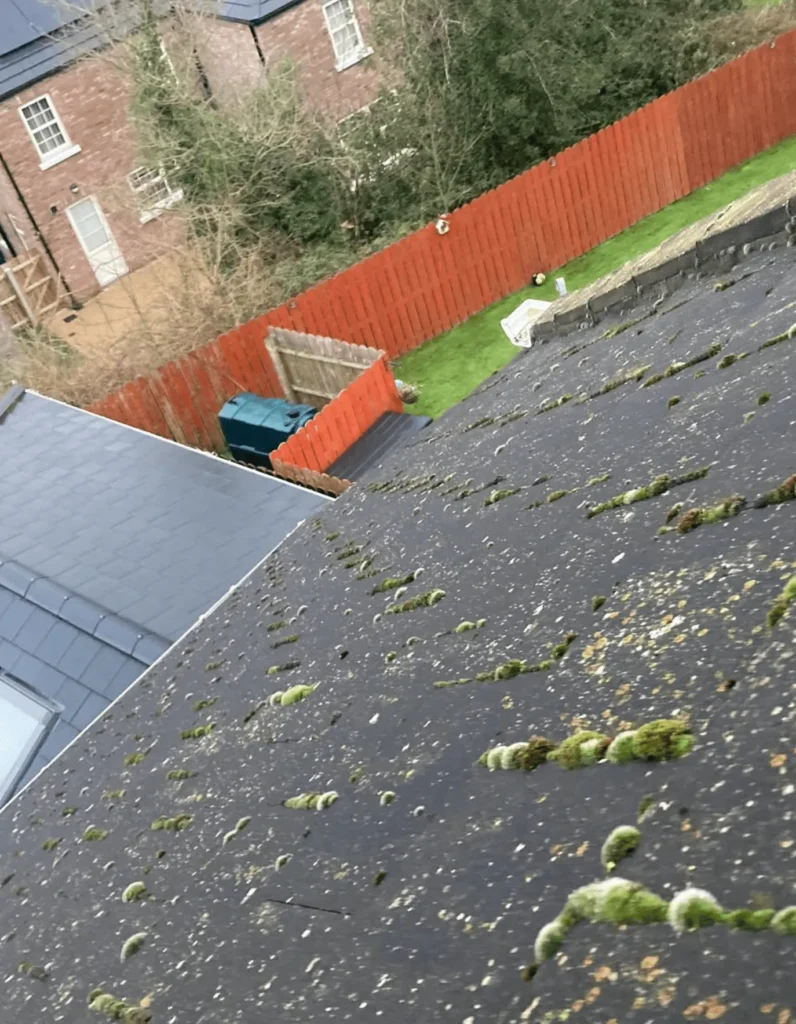
Roof Algae: Algae appear as black streaks running down your roof surfaces. The most common type of roof algae is Gloeocapsa magma, a blue-green algae that thrives in humid areas and areas with limited sunlight. This alga feeds on the limestone filler in asphalt shingles, causing black discolouration and potential roof damage. The black streaks caused by algae are primarily cosmetic but can lead to organic growth that compromises the roofing materials over time.
Moss: Moss is a green, soft plant that grows in shaded areas with moist surfaces. Unlike algae, moss has roots that can lift and penetrate shingles, causing roof damage and potential leaks. Moss can trap moisture against the roof surface, accelerating the deterioration of roofing materials such as asphalt shingles, metal roofs and tile roofs. Moss growth is bad because it can lead to mould growth and other organic matter accumulation on the roof, more structural issues.
Algae and Moss
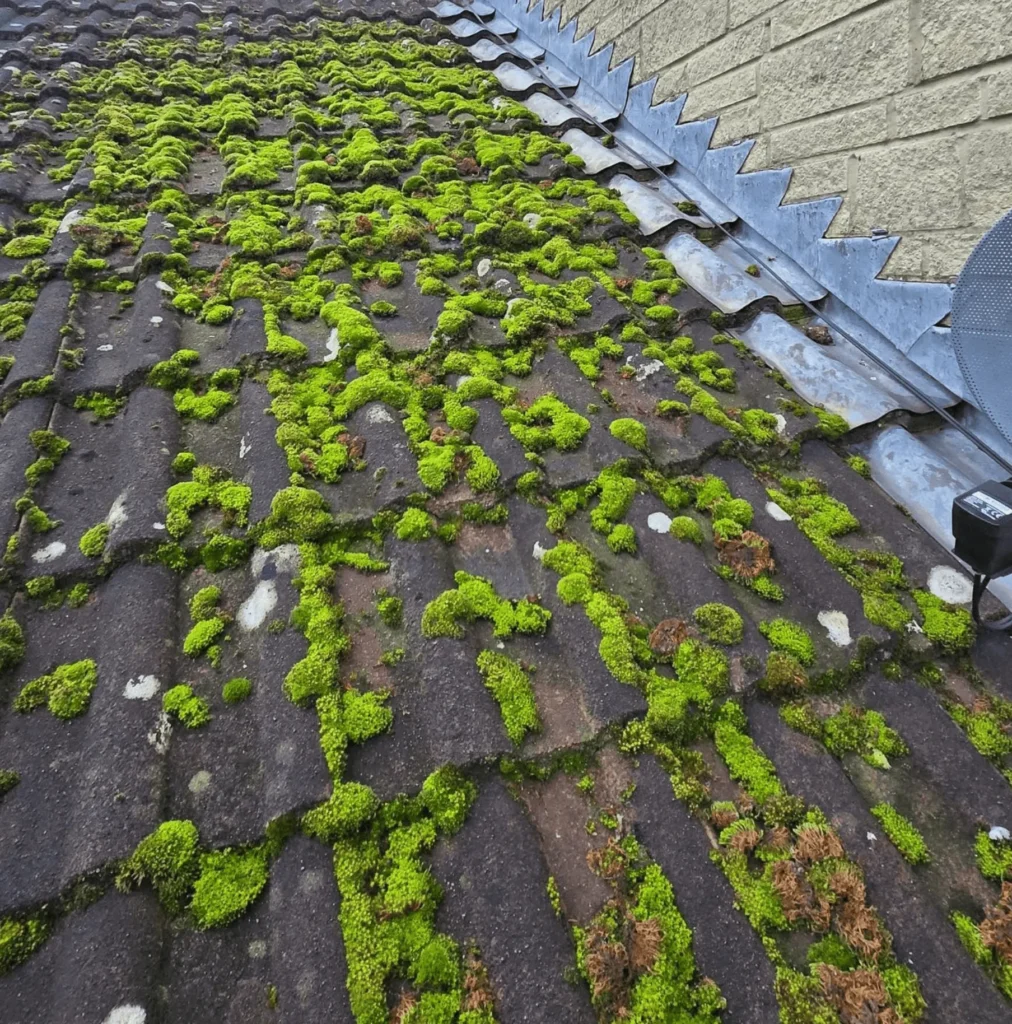
Different roofing materials react differently to moss and algae. Knowing how they respond can help you decide on the best roof cleaning method and maintenance.
Asphalt Shingles: The most common roofing material, asphalt shingles are prone to algae and moss growth due to the limestone filler in them. Over time, black algae can degrade the shingles, and shingle blow off in storms. Moss can also lift the shingles and create gaps where water can get in and cause water damage and rot.
Metal Roofs: Metal roofs are more resistant to moss and algae than asphalt shingles but not immune. Moss can still grow on the surface, especially in shaded areas. This can cause organic growth that holds moisture against the metal and can cause rust and structural damage over time.
Tile Roofs: Tile roofs are more durable but can still be affected by moss and algae. Moss can grow in the crevices between tiles and cause water damage and tiles to crack or break. Regular cleaning is necessary to prevent moss from growing in these areas.
Why Remove Roof Algae and Moss?
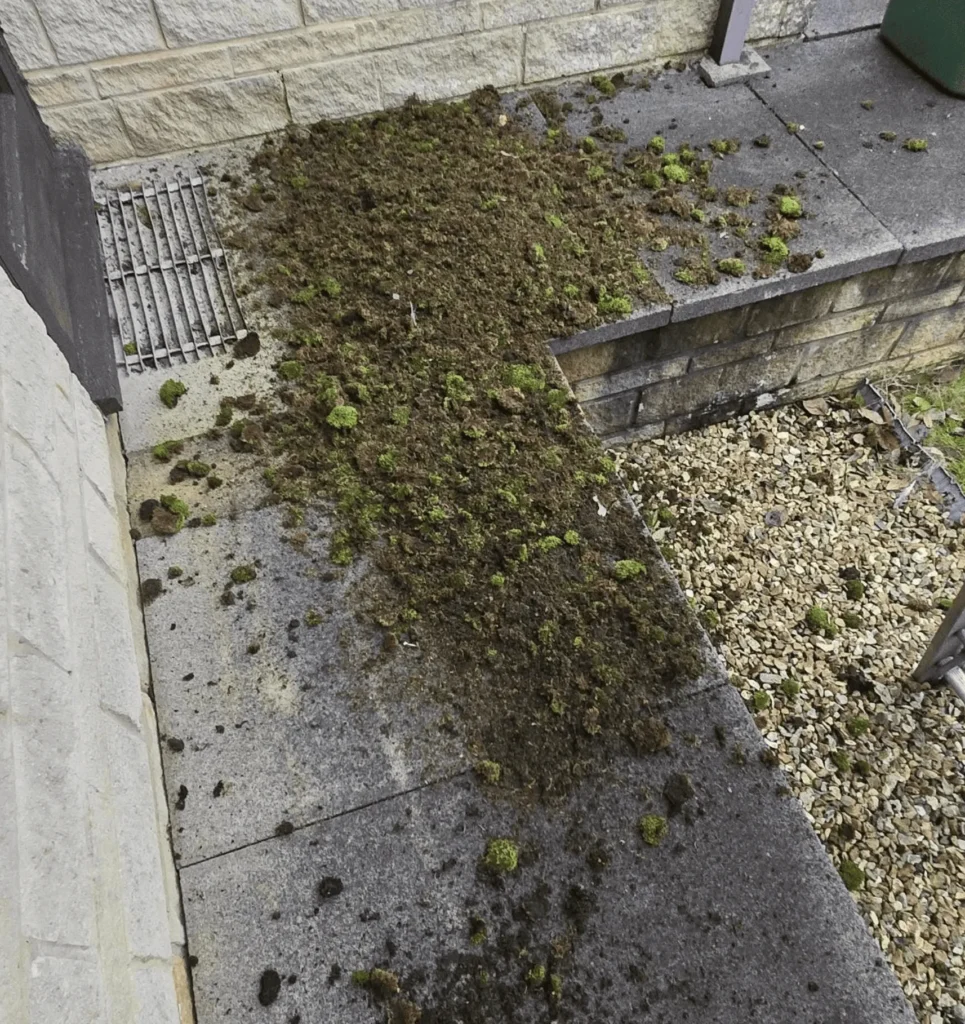
Algae growth and moss growth can be very detrimental if not addressed. These organisms not only reduce the curb appeal of your home but also pose severe risks to the structural integrity of your roof. Here are the reasons why you need to act fast:
- Structural Damage: Moss holds moisture against the roof surface, which can cause the deterioration of the roofing materials. Over time, this moisture can cause rot, especially in wooden structures, and can lead to structural issues that may require roof repairs or even a total roof replacement.
- Water Damage: Moss growth can lift shingles and create gaps where water can get into the roof. This can cause water damage in the roof deck and attic and can lead to leaks, mould, and mildew growth inside your home.
- Energy Efficiency: Algae can cause black streaks on your roof, which absorbs more heat from the sun. This can increase your cooling cost in the summer as your roof is less reflective and more heat is absorbed into your home.
- Curb Appeal: The presence of black streaks, moss growth and other signs of roof algae can greatly reduce the curb appeal of your home. This can be a major concern if you’re planning to sell your house as potential buyers may be turned off by the appearance of a dirty roof or assume that the roof needs costly repairs.
- Health Risks: The presence of algae and moss on your roof can lead to mould growth, which can cause health issues to the occupants, especially those with allergies or respiratory conditions. Removing these organisms is necessary to maintain a healthy living environment.
Prevention Techniques
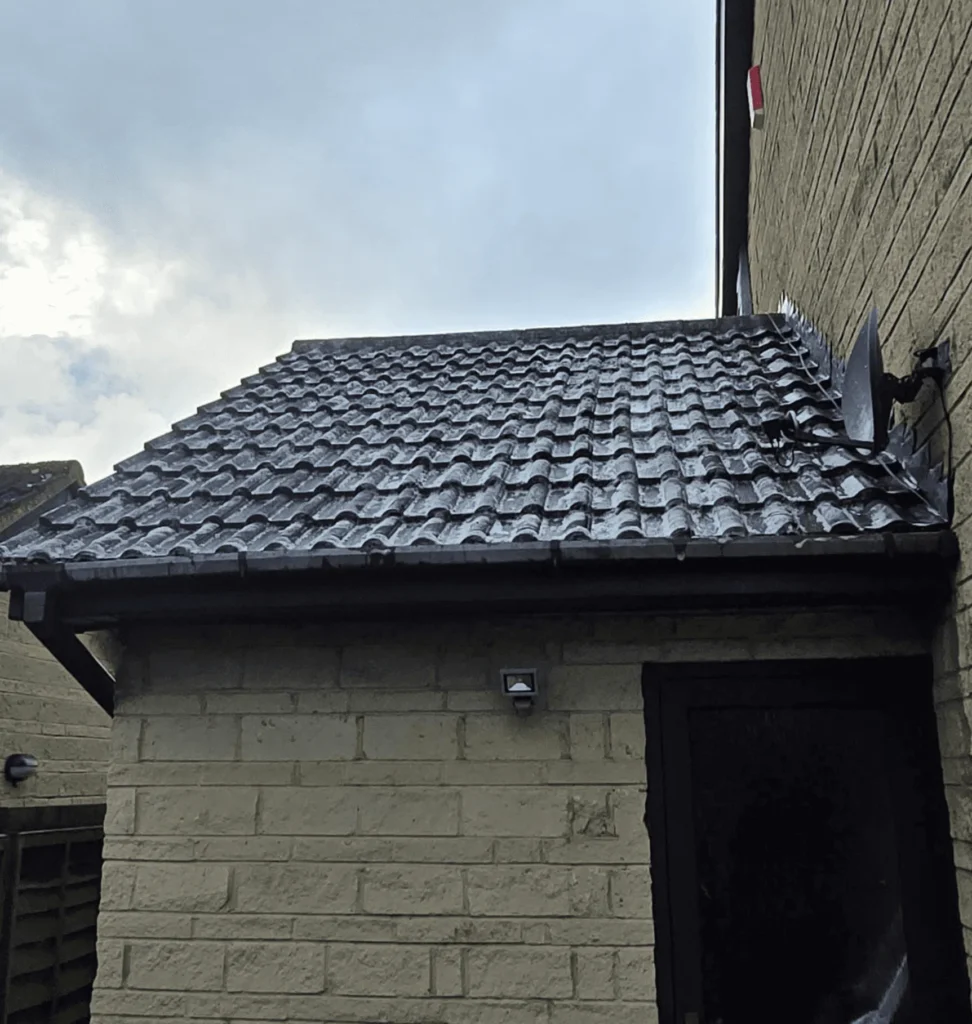
Preventing moss and algae from growing on your roof is way easier and cheaper than dealing with an infested roof. Here are some prevention methods to keep your roof in top shape:
- Install Zinc or Copper Strips:
- Copper strips or zinc strips along the roof’s ridge line are a super effective prevention method against algae and moss. When it rains, small amounts of metal ions from these strips are washed down the roof and create an environment that’s hostile to these critters. This is a popular method because it’s long lasting and low maintenance.
- Trim Overhanging Trees:
- Overhanging branches create shaded areas that are perfect for moss growth. Trimming these trees allows more sunlight to hit the roof, reducing the moisture that promotes moss and algae growth. Plus, trimming trees prevents leaves and other organic debris from accumulating on the roof which can contribute to moss and algae issues.
- Make Sure Proper Drainage:
- Proper drainage is critical to preventing water damage and moss growth. Make sure your gutters are clean and functioning properly to prevent water from pooling on the roof. Proper drainage ensures moisture doesn’t linger on the roof surface, reducing the chance of algae and moss taking hold.
- Use Algae-Resistant Shingles:
- Algae-Resistant Shingles are designed to prevent algae growth. These shingles are coated with copper granules or other substances that inhibit algae growth. Investing in these shingles will give you long lasting results and save you from the costly repairs of an algae infested roof.
- Regular Maintenance:
- Regular roof maintenance is the best way to prevent moss growth and algae. This means inspecting your roof at least twice a year for moss growth, algae and other potential issues. By catching these problems early, you can address them before they cause damage.
Removal Methods
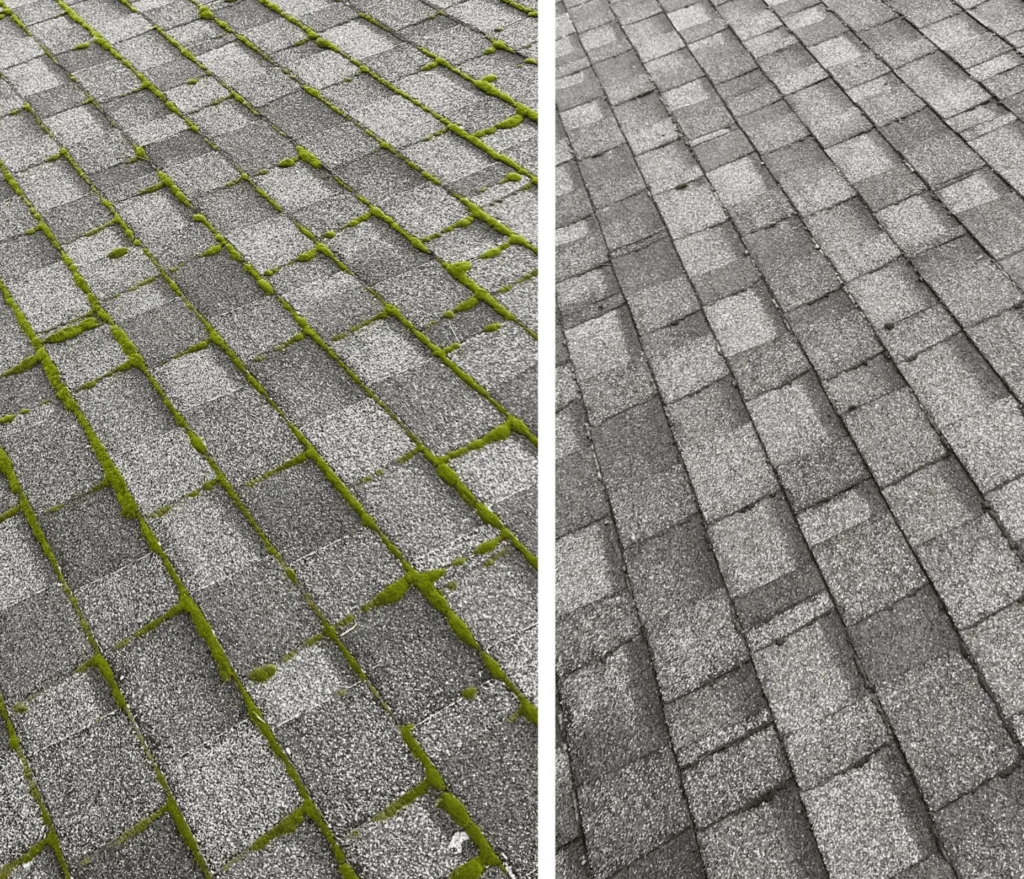
If your roof is already showing signs of moss growth or algae, you need to act fast. There are many roof cleaning methods available, from DIY solutions to professional services. Below we list the most effective methods to remove moss and algae from your roof.
- Manual Removal:
- For small areas of moss growth, manual removal is a simple and effective solution. Use a long handled soft bristle brush or soft bristled brush to gently remove the moss from the roof. Make sure to brush downwards to avoid lifting the shingles which could damage the roof. This method is best for delicate roofing materials where pressure washing would be too harsh.
- Pressure Washing:
- Pressure washing can be an effective method for removing both moss and algae but be careful. High pressure washing can strip granules from shingles, causing permanent damage and reducing the life of the roof. If you do use a pressure washer make sure to use low pressure and keep the spray at a shallow angle to avoid damaging the shingles. Professional roof cleaners have the equipment to do high pressure cleaning safely.
- Soft Washing:
- Soft washing is a gentler alternative to high pressure cleaning and is one of the safest methods for cleaning roofs. This method uses a chemical solution to kill algae and moss, followed by a soft wash with low pressure water to rinse the roof. Soft washing is effective for delicate materials such as bitumen roof shingles and concrete tiles. It’s a popular method because it minimises the risk of damage to the roof while removing moss and algae.
- Chemical Treatments:
- There are many chemical solutions to kill moss and algae. These include biocidal roof wash, bleach solution and other special cleaning solutions. When using chemicals make sure to follow the manufactures instructions to avoid damaging your roof or surrounding plants. Applying a chemical solution can be done with a backpack sprayer or low pressure sprayer for even coverage. This method is often used in conjunction with soft washing for long lasting results.
- Hiring Professional Services:
- For extensive moss growth or if you’re not sure about the cleaning methods, hiring professional services is often the best option. Professional companies like Vertex Cleaning Solutions, Pinnacle Home Improvements, and Pickard Roofing have experience in roof moss removal and the right tools and knowledge to clean your roof safely. Professional roof cleaners also take safety very seriously, using safety gear such as non-slip shoes, safety glasses and safety harnesses to prevent accidents.
Safety Precautions When Cleaning
Roof cleaning can be a dangerous job, especially when you’re working on steep or shingle roofs. Here are some safety precautions to follow to avoid injury and roof damage:
- Wear the Right Gear:
- Always wear gear when on a roof. This includes safety glasses to protect your eyes from debris, a harness to prevent falls and non-slip shoes or slip resistant shoes to get better grip on the roof surface.
- Choose the Right Time:
- Don’t clean your roof on windy or rainy days, as these conditions increase the risk of slipping and falling. Early morning or late afternoon is the best time to clean a roof as the surface is more relaxed and less slippery.
- Use the Right Tools:
- Make sure you have the right tools for the job, soft brush, long handled soft bristle brush or low pressure sprayer. Using the wrong equipment like high pressure washer on a delicate roof can cause permanent damage.
- Be Careful with Chemicals:
- When using chemical solutions like bleach solution or biocidal roof wash, cover nearby plants with plastic sheets. Wear protective clothing and avoid skin and eye contact.
- Check Your Roof:
- Before you start cleaning inspect your roof for any damage like loose or cracked shingles which can get worse during the cleaning process. If your roof is in poor condition it’s best to call a professional cleaning service to avoid causing more damage.
Professional Services
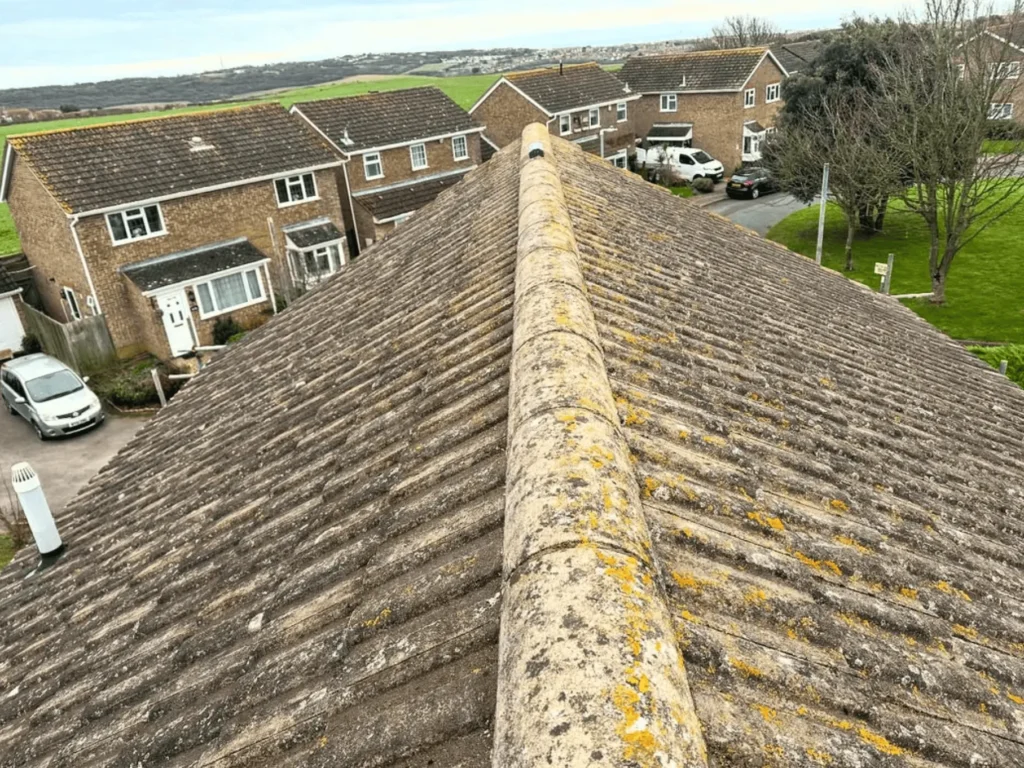
While DIY roof cleaning can work for minor moss growth and algae, there are times when hiring professional cleaning services is the way to go. Professional roof cleaners have the expertise and access to unique cleaning solutions that most homeowners don’t. Here are the benefits:
- Experience and Expertise:
- Professional companies have years of experience with different types of roofs and roofing materials. They know the challenges of moss growth and algae and how to fix it without causing more damage.
- Specialised Equipment:
- Professional cleaners use equipment that most homeowners don’t have. Low-pressure sprayers, soft washing techniques and chemical solutions for roof cleaning. This equipment ensures the job is done safely and effectively.
- Safety:
- Cleaning a roof is dangerous, especially if you’re working on steep roofs or multi-story buildings. Professional roof cleaners are trained in safety precautions and have the right gear to prevent accidents. They also have insurance, so you’re covered if something goes wrong.
- Long Lasting Results:
- Hiring professional services often means long lasting results. They use effective cleaning methods and preventative measures to keep your roof moss and algae free for a long time.
- Cost Effective in the Long Run:
- While hiring a professional may seem like an extra expense, it will save you money in the long run by preventing costly repairs. Professional roof cleaners can identify potential issues before they become major problems and help you keep a well-maintained roof for years.
Summary
Roof algae and moss growth is part of roof maintenance. While it may seem minor at first, it can cause structural damage and costly repairs if not treated. By knowing the causes of moss growth and algae, taking preventative measures and using the right removal methods, you can keep your roof in top shape and boost your home’s curb appeal. Whether you do it yourself or hire a moss removal company, roof cleaning Melbourne is essential—do it now and save time, money, and stress later.
FAQ
What makes moss and algae grow on roofs?
Moss and algae love shaded areas with wet surfaces. Algae growth is often caused by blue-green algae that feed on the limestone filler in asphalt shingles. Moss grows in areas with limited sunlight where moisture is trapped.
Can moss and algae hurt my roof?
Yes, both moss and algae can damage your roof. Moss holds moisture against the roof surface and causes rot and water damage. Algae degrades roofing materials and causes black streaks that ruin your roof’s looks.
How do I prevent moss and algae from growing on my roof?
Preventative measures are to install copper strips or zinc strips to prevent growth, trim overhanging trees to let more sunlight in, ensure proper water drainage and regular maintenance to keep your roof clean.
Is it safe to use a pressure washer on my roof?
Pressure washing can work but be careful. High pressure washing can damage roofing materials permanently so it’s recommended to use low pressure water or hire a professional cleaning service to not damage your roof.
Do I need to hire a professional?
Hiring a professional roof cleaner is usually the way to go especially for heavy moss growth or if your roof is old. They have the experience, equipment and knowledge to clean your roof safely and efficiently for long term results.
